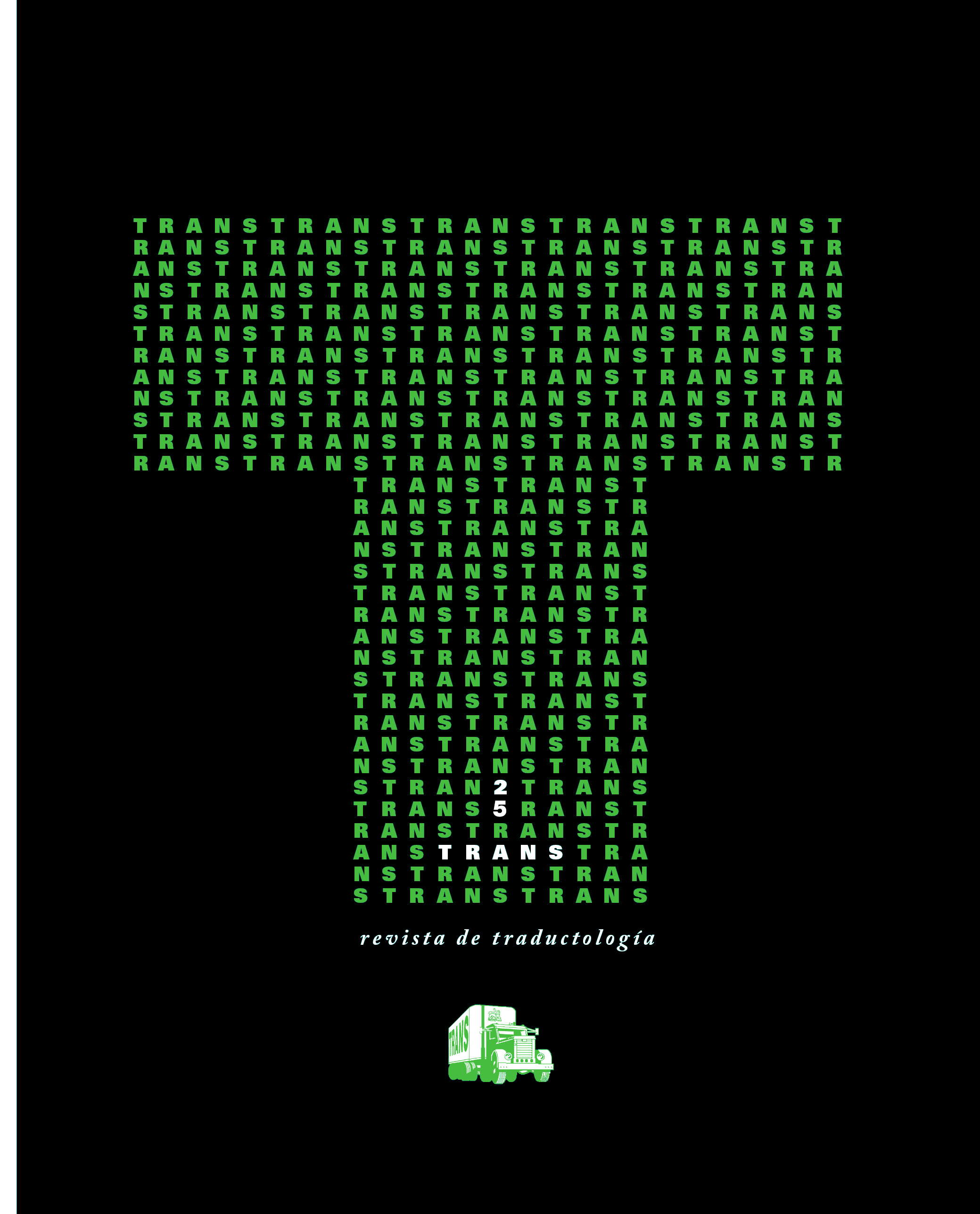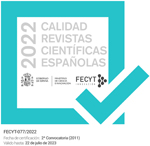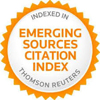«No lo sé, yo solo soy la intérprete»: primera aproximación al papel de los intérpretes sanitarios más allá de encuentros médicos bilingües
DOI:
https://doi.org/10.24310/TRANS.2021.v1i25.10128Palabras clave:
Interpretación sanitaria, actividades mediadas por intérprete, papel, observación participante, análisis temáticoResumen
El papel del intérprete sanitario ha inquietado a los investigadores desde hace tiempo. Sin embargo, la mayoría de estudios abordan este constructo en el transcurso de consultas médicas, dejando en cierto modo desatendidos otros espacios y actividades donde también participan intérpretes. Este artículo persigue contribuir a una mejor comprensión del papel de los intérpretes sanitarios en estos espacios. Mediante la observación participante, se examinaron los roles adoptados por cinco intérpretes en un hospital de Madrid durante cinco meses en actividades diferentes a interacciones entre proveedor y usuario (p. ej. esperas junto al paciente). Se identificaron siete roles clave fuera de las consultas: mediador intercultural, mediador moral, defensor del paciente, navegador institucional, embajador de la salud, recopilador de información y colega/compañero conversacional. Un resultado importante es que la mayoría de eventos donde participan los intérpretes ocurren fuera de consultas médicas, por lo que debe desviarse el foco hacia roles desempeñados en estos espacios alternativos. Comprender el papel que juegan intérpretes sanitarios en diferentes actividades dentro del terreno de los escenarios de atención médica es crucial para construir una visión precisa de lo que ser solo un intérprete verdaderamente significa.
Descargas
Métricas
Publicación Facts
Perfil de revisores N/D
Información adicional autores
Indexado: {$indexList}
-
Indexado en
- Sociedad Académica/Grupo
- N/D
- Editora:
- Universidad de Málaga
Citas
AGUIRRE FERNÁNDEZ BRAVO, Elena (2019): «Interpreter role (self-)perception: a model and an assessment tool», Revista de Llengua i Dret, Journal of Language and Law, 71, 62-72.
AMZAT, Jimoh & Oliver RAZUM, (2014): Medical Sociology in Africa, London: Springer.
ANGELELLI, Claudia V. (2004): Revisiting the interpreter's role: a study of conference, court, and medical interpreters in Canada, Mexico and the United States, Ámsterdam y Filadelfia: John Benjamins Publishing Company.
ANGELELLI, Claudia V. (2019): Healthcare interpreting explained, Oxon & Nueva York: Routledge.
ARANGURI, Cesar, Brad DAVIDSON & Robert RAMIREZ (2006): «Patterns of communication through interpreters: a detailed sociolinguistic analysis», Journal of General Internal Medicine, 21/6, 623-629, doi: 10.1111/j.1525-1497.2006.00451.x.
BELTRAN AVERY, María Paz (2001): The role of the healthcare interpreter: an evolving dialogue, Washington: NCIHC.
BENAMAR, Lamya, Christine BALAGUÉ & Mohamad GHASSANY (2017): «The identification and influence of social roles in a social media product community», Journal of Computer-Mediated Communication, doi: 10.1111/jcc4.12195.
BISCHOFF, Alexander, Elisabeth KURTH & Alix HENLEY (2012): «Staying in the middle. A qualitative study of health care interpreters’ perceptions of their work», Interpreting 14/1: 1-22, doi: 10.1075/intp.14.1.01bis.
BOLDEN, Galina (2000): «Toward understanding practices of medical interpreting: Interpreters' involvement in history taking», Discourse studies 2/4: 387-419, doi: 10.1177/1461445600002004001.
BOWLING, Nathan (2017): «Role conflict», in Steven G. ROGELBERG (ed.), The Sage Encyclopedia of Industrial and Organizational Psychology, Thousand Oaks: Sage.
BUTOW, Phyllis, Melanie BELL, David GOLDSTEIN, Ming SZE, Lynley ALDRIDGE, Sarah ABDO, Michelle MIKHAIL, Skye DONG, Rick IEDEMA, Ray ASHGARI, Rina HUI & Maurice EISENBRUCH (2011): «Grappling with cultural differences; communication between oncologists and immigrant cancer patients with and without interpreters», Patient Educ Couns, 84/3, 398-405, doi: 10.1016/j.pec.2011.01.035.
CAMBRIDGE, Jan (2002): «Interlocutor roles and the pressures on interpreters», en Carmen Valero Garcés y Guzmán Mancho Barés (eds.), Traducción e interpretación en los servicios públicos: nuevas necesidades para nuevas realidades/Community interpreting and translating: New needs for new realities, Alcalá de Henares: Servicio de Publicaciones de la Universidad de Alcalá, 119-124.
CREZEE, Ineke & Cynthia ROAT (2019): «Bilingual patient navigator or healthcare interpreter: What’s the difference and why does it matter?», Cogent Medicine, 6/1, doi: 10.1080/2331205X.2019.1582576
DAVIDSON, Brad (2000): «The interpreter as institutional gatekeeper: The social?linguistic role of interpreters in Spanish?English medical discourse», Journal of Sociolinguistics, 4/3, 379-405, doi: 10.1111/1467-9481.00121.
FATAHI, Nabi, Bengt MATTSSON, Jasaf HASANPOOR & Carola SKOTT (2005): «Interpreters’ experiences on general practitioner-patient encounters», Scandinavian Journal of Primary Health Care, 23, 159-163, doi: 10.1080/02813430510018509
GOFFMAN, Erving (1969): The presentation of self in everyday life, London: Allen Lane.
GRANHAGEN JUNGNER, Johanna, Elisabet TISELIUS, Klas BLOMGREN, Kim LÜTZÉN & Pernilla PERGERTA (2019): «The interpreter’s voice: Carrying the bilingual conversation in interpreter-mediated consultations in pediatric oncology care», Patient Education Counselling, 102/4, 656-662, doi: 10.1016/j.pec.2018.10.029
GREEN, Judith, Caroline FREE, Vanita BHAVNANI & Tony NEWMAN (2005): «Translators and mediators: bilingual young people's accounts of their interpreting work in health care», Social Science & Medicine, 60/9, 2097-2110, doi: 10.1016/j.socscimed.2004.08.067
HAVIGHURST, Robert & Bernice NEUGARTEN (1962): Society and education, New York: Allyn & Bacon.
HERRMANN, Thomas, Isa JAHNKE, & Kai-Uwe LOSER (2004): «The role concept as a basis for designing community systems», Journal of Computer-Mediated Communication, 22/6, 337-362, doi: 10.1111/jcc4.12195
HSIEH, Elaine (2007): «Interpreters as co-diagnosticians: Overlapping roles and services between providers and interpreters», Social Science & Medicine, 64/4, 924-937, doi: 10.1016/j.socscimed.2006.10.015
HSIEH, Elaine (2013): «Health literacy and patient empowerment: The role of medical interpreters in bilingual health care», in Mohan J. DUTTA & Gary L. KREPS (eds.): Reducing health disparities: communication intervention, New York: Peter Lang.
JACKSON, Susan E., & SCHULER, Randall S. (1985): «A meta-analysis and conceptual critique of research on role ambiguity and role conflict in work settings», Organizational Behavior and Human Decision Processes, 36/1, 16–78, doi: 10.1016/0749-5978(85)90020-2
KENDALL, Diana (2007): Sociology in Our Times: The Essentials, Belmont: Wadsworth Cengage Learning.
KRYSTALLIDOU, Demi, Ignaas DEVISCH, Dominique VAN DE VELDE & Peter PYPE (2017): «Understanding patient needs without understanding the patient: The need for complementary use of professional interpreters in end-of-life care», Medicine Health Care and Philosophy, 20/4, 477-481, doi: 10.1007/s11019-017-9769-y
LARA-OTERO, Karlena, Jon WEIL, Claudia GUERRA, Janice KA YAN CHENG, Janey YOUNGBLOM & Galen JOSEPH (2019): «Genetic counselor and healthcare interpreter perspectives on the role of interpreters in cancer genetic counseling», Health Communication, 34/13, 1608-1618, doi: 10.1080/10410236.2018.1514684
LAUFFER, Armand (2011): Understanding your social agency, Thousand Oaks & London: Sage.
LÁZARO GUTIÉRREZ, Raquel (2014): «Use and abuse of an interpreter», in Carmen VALERO GARCÉS, Bianca VITALARU & Esperanza MOJICA LÓPEZ (eds.): (Re)considerando ética e ideología en situaciones de conflicto=(Re)visiting ethics and ideology in situations of conflict, Alcalá de Henares: Servicio de Publicaciones de la Universidad de Alcalá, 214-221.
LEANZA, Yvan (2005): «Roles of community interpreters in pediatrics as seen by interpreters, physicians and researchers», Interpreting 7/2, 167-192, doi: 10.1075/intp.7.2.03lea
LEANZA, Yvan, Alessandra MIKLAVCIC, Isabelle BOIVIN & Ellen ROSENBERG (2014): «Working with interpreters», en Laurence Kirmayer, Jaswant Guzder & Cécile Rousseau (eds.), International and cultural psychology. Cultural consultation: Encountering the other in mental health care, Springer Science + Business Media, doi: 10.1007/978-1-4614-7615-3_5
LI, Shuangyu, Jennifer GERWING, Demi KRYSTALLIDOU, Angela ROWLANDS, Antoon COX & Peter PYPE. (2017): «Interaction—a missing piece of the jigsaw in interpreter-mediated medical consultation models», Patient Education and Counseling, 100/9, 1769-1771, doi: 10.1016/j.pec.2017.04.021
LIU, Yubo & Wei ZHANG (2019): «Unity in diversity: mapping healthcare interpreting studies (2007-2017)», Medical Education Online, 24/1, 1-14, doi: 10.1080%2F10872981.2019.1579559
MAJOR, George & NAPIER, Jemina (2019): «"I'm there sometimes as a just in case": Examining role fluidity in healthcare interpreting», in Multicultural Health Translation, Interpreting and Communication, Routledge, 183-204, doi: 10.4324/9781351000390
MARTÍNEZ FERRANDO, Cristina (2015): Interpretación médica: de la teoría a la práctica a partir de estudios de caso. (Masters’ Dissertation. Universitat d’Alacant). <http://hdl.handle.net/10045/62008>
MARTÍNEZ GÓMEZ, Aída (2015): «Invisible, visible or everywhere in between? Perceptions and actual behaviors of non-professional interpreters and interpreting users», The Interpreters' Newsletter, 20, 175-194. <https://www.openstarts.units.it/handle/10077/11859>
MASON, Ian & Wen REN (2012): «Power in face-to-face interpreting events», in Claudia V. ANGELELLI (ed.), The Sociological Turn in Translation and Interpreting Studies, 234-256, Ámsterdam & Filadelfia: John Benjamins Publishing Company.
PARENZO, Sarah & Michal SCHUSTER (2019): «The mental health interpreter: The “third space” between transference and counter-transference», in Izabel E. T. de V. Souza & Effrossyni Fragkou (eds.), Handbook of Research on Medical Interpreting, IGI GLOBAL, 276-289.
PENN, Claire, Jennifer WATERMEYER, Tom KOOLE, Janet DE PICCIOTTO, Dale OGILVY, & Mandy FISCH (2010): «Cultural brokerage in mediated health consultations: An analysis of interactional features and participant perceptions in an audiology context, JIRCD Journal of Interactional Research in Communication Disorders, 1, 135-156.
POPE, Catherine, Nicholas MAYS & Jennie POPAY (2007): Synthesizing Qualitative and Quantitative Health Evidence. A Guide to Methods, Maidenhead: Open University Press.
RESERA, Elena, Rachel TRIBE, & Pauline LANE (2015): «Interpreting in mental health, roles and dynamics in practice», International Journal of Culture and Mental Health, 8/2: 192-206, doi: 10.1080/17542863.2014.921207
ROSENBAUM, Marc, Richard DINEEN, Karen SCHMITZ, Jessica STOLL, Melissa HSU & Priscila D. HODGES (2020): «Interpreters’ perceptions of culture bumps in genetic counseling», Journal of Genetic Counseling, doi: 0.1002/jgc4.1246
SEALE, Clive, Carol RIVAS, Hela AL-SARRAJ, Sarah WEBB, Moira KELLY (2013): «Moral mediation in interpreted health care consultations», Social Science and Medicine, 98, 141-148, doi: 10.1016/j.socscimed.2013.09.014
SHOWSTACK, Rachel E. (2020): «Making sense of the interpreter role in a healthcare service-learning program», Applied Linguistics, doi: 10.1093/applin/amz058
SILVA, Milagros D., Stephanie TSAI, Rosanna M. SOBOTA, Brittany T. ABEL, M. CARRINGTON REID & Ronald D. ADELMAN (2020): «Missed opportunities when communicating with limited English-proficient patients during end-of-life conversations: Insights from Spanish-speaking and Chinese-speaking medical interpreters, » Journal of Pain and Symptom Management, 59/3, 694-701, doi: 10.1016/j.jpainsymman.2019.10.019
SLEPTSOVA, M., Gertrud HOFER, Naser MORINA & Wolf LANGEWITZ (2014): «The role of the health care interpreter in a clinical setting—A narrative review», Journal of Community Health Nursing, 31/3, 167-184, doi: 10.1080/07370016.2014.926682
SUURMOND, Jeanine, Anke WOUDSTRA, & Marie-Louise ESSINK-BOT (2016): «The interpreter as co-interviewer: the role of the interpreter during interviews in cross-language health research», Journal of Health Services Research & Policy, 21/3, 172-177.
THOMAS, Susan & WOLFENSBERGER, Wolf (1999): «An overview of social role valorization», in Robert J. Flynn & Raymond A. Lemay (eds.), A Quarter-century of Normalization and Social Role Valorization: Evolution and Impact, Otawa, University of Ottawa Press, 125-160.
ZENDEDEL, Rena, Barbara SCHOUTEN, Julia C. M. VAN WEERT & Bas Van DEN PUTTE (2018): «Informal interpreting in general practice: the migrant patient’s voice», Ethnicity and Health, 23/2, 158-173, doi: 10.1080/13557858.2016.1246939
ZHAN, Cheng & Lishan ZENG (2017): «Chinese medical interpreters’ visibility through text ownership. An empirical study on interpreted dialogues at a hospital in Guangzhou», Interpreting, 19/1, 97-117, doi: 10.1075/intp.19.1.05zha
ZORZI, Daniela (2012): «Mediating assessments in healthcare settings», in Claudio BARALDI & Laura GAVIOLI (eds.), Coordinating Participation in Dialogue Interpreting, Ámsterdam & Filadelfia: John Benjamins Publishing Company, 229-250.
Publicado
Cómo citar
Número
Sección
Licencia
Todos los contenidos publicados en TRANS. Revista de Traductología están sujetos a la licencia Creative Commons Reconocimento-NoComercia-Compartirigual 4.0 cuyo texto completo puede consultar en <http://creativecommons.org/licenses/by-nc-sa/4.0>
Se pueden copiar, usar, difundir, transmitir y exponer públicamente, siempre que:
- Se cite la autoría y la fuente original de su publicación (revista, editorial y URL de la obra).
- No se usen para fines comerciales.
- Se mencione la existencia y especificaciones de esta licencia de uso.
- Compartir Igual — Si remezcla, transforma o construye sobre el material, debe distribuir sus contribuciones bajo la misma licencia que el original.
Los derechos de autor son de dos clases: morales y patrimoniales. Los derechos morales son prerrogativas perpetuas, irrenunciables, intransferibles, inalienables, inembargables e imprescriptibles. De acuerdo con la legislación de derechos de autor, TRANS. Revista de Traductología reconoce y respeta el derecho moral de los autores/as, así como la titularidad del derecho patrimonial, el cual será cedido a la Universidad de Málaga para su difusión en acceso abierto. Los derechos patrimoniales, se refieren a los beneficios que se obtienen por el uso o divulgación de las obras. TRANS. Revista de Traductología se publica en open access y queda autorizada en exclusiva para realizar u autorizar por cualquier medio el uso, distribución, divulgación, reproducción, adaptación, traducción o transformación de la obra.
Es responsabilidad de los autores/as obtener los permisos necesarios de las imágenes que están sujetas a derechos de autor.
Los autores/as cuyas contribuciones sean aceptadas para su publicación en esta revista conservarán el derecho no exclusivo de utilizar sus
contribuciones con fines académicos, de investigación y educativos, incluyendo el auto-archivo o depósito en repositorios de acceso abierto de cualquier tipo.













21.png)
